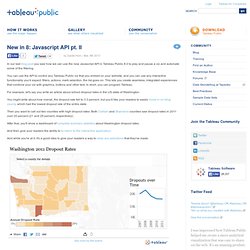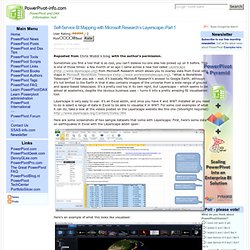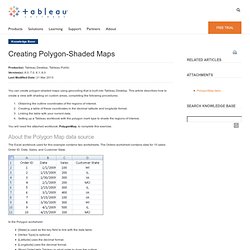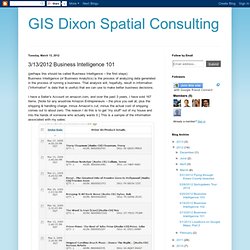

New in 8: Javascript API pt. II. In our last blog post you saw how we can use the new Javascript API in Tableau Public 8.0 to play and pause a viz and automate some of the filtering.

You can use the API to control any Tableau Public viz that you embed on your website, and you can use any interactive functionality you'd expect: filters, actions, mark selection, the list goes on. WorldWide Telescope. Layerscape. Self-Service BI Mapping with Layerscape. Reposted from Chris Webb's blog with the author's permission.

Sometimes you find a tool that is so cool, you can’t believe no-one else has picked up on it before. This is one of those times: a few month or so ago I came across a new tool called Layerscape ( from Microsoft Research which allows you to overlay data from Excel onto maps in Microsoft WorldWide Telescope ( “What is WorldWide Telescope?” I hear you ask – well, it’s basically Microsoft Research’s answer to Google Earth, although it’s not limited to the Earth in that it also contains images of the universe from a wide range of ground and space-based telescopes. Training & Tutorials. Skip to main content Tableau Training & Tutorials Tableau provides a variety of training options to help you get the most out of your data.

Quickly improve your Tableau performance and skills through traditional classroom learning, live-online training and self-paced on-demand courses. Our training programs help you master our software and learn how to put it to work for you and your organization. Advanced Training - Mapping. Deploying a WMS for use with Tableau. You can deploy your own instance of the GeoServer WMS (web map service) for use with Tableau.

Here are the suggested main steps: Install the Java Development Kit (JDK). Install GeoServer. Connect to a Web Map Service and test the installations.Important: Tableau does not support or test third party WMS map providers like GeoServer WMS. This article is intended to provide general guidance on certain configurations that may allow Tableau to connect to WMS map services provided by GeoServer WMS. Mapping Basics. Creating map views in Tableau is quick and easy.

This document will walk through setting up a basic map using the Superstore Sales example included with Tableau Desktop. Mapping Basics You can assign Geographic Roles to fields that contain geographic data such as country/region names, state names, zip codes, and so on. Fields with a Geographic Role will automatically generate longitude and latitude coordinates for display on a map view. Tableau automatically assigns Geographic Roles to fields with common location names such as State, County, etc. Step 1. Creating Choropleth Maps. The BITE Group’s Giedre Aleknonyte focused on explaining two key things during her highly entertaining session Wednesday morning.

First, BITE is embroiled in some seriously intense competition with the other Lithuanian mobile operators. Market penetration is well over 100 percent, with many Lithuanians owning three mobile phones (taking advantage of ridiculously low rates and free unlimited in-network calling). Next, she walked through the creation of a sweet choropleth map (a geographically based heat map) using the custom shapes feature in Tableau. Choropleth Maps with Tableau. Polygon Files Structures - Solid Color Maps. Tableau Polygons from Shapefiles. Beginning in version 7.0, you can use the filled maps chart option to fill worldwide states and provinces and U.S. counties using built-in geocoding.

Maps that require more detailed areas such as cities, zip codes, area codes, or custom areas, use the ArcGIS ShapeFiles to prepare and define a file that can be imported into Tableau Desktop as a polygon layer. For more general information about polygon filled areas, refer to Creating Polygon-Shaded Maps article. The method requires a licensed version of ArcGIS (ArcView, ArcEditor, or ArcInfo) and the ET GeoWizards tool for ArcGIS. The software installs as a toolbar in ArcMap and the functionality required for preparing the Shapefile is covered under their free features. Prepare the shapefile Step 1. Creating Polygon-Shaded Maps. You can create polygon-shaded maps using geocoding that is built into Tableau Desktop.

This article describes how to create a view with shading on custom areas, completing the following procedures: Obtaining the outline coordinates of the regions of interest. Creating a table of these coordinates in the decimal latitude and longitude format. Clearly and Simply: Choropleth Maps. A step-by-step guide to Richard Leeke’s TabGeoHack for creating your own filled maps in Tableau Software Way back in 2009, we had a beautiful guest post by Giedre Aleknonyte describing a workaround to generate Choropleth Maps with Tableau (using version 5.0 by the way).

Those days are over. One of the major new features of Tableau 7 is Filled Maps (or Choropleth Maps as we used to call them in all blog posts here). Tableau Tip: How to Build a Combination Area Fill & Symbol Map. Preparing Data for Tableau: 1 of 3. Magic Quadrant for Business Intelligence Platforms. BI 101. (perhaps this should be called Business Intelligence – the first steps)Business Intelligence (or Business Analytics) is the process of analyzing data generated in the process of running a business.

That analysis will, hopefully, result in information (“information” is data that is useful) that we can use to make better business decisions. I have a Seller’s Account on amazon.com, and over the past 3 years, I have sold 167 items. [Note for any would-be Amazon Entrepreneurs – the price you sell at, plus the shipping & handling charge, minus Amazon’s cut, minus the actual cost of shipping comes out to about zero. The reason I do this is to get “my stuff” out of my house and into the hands of someone who actually wants it.]
This is a sample of the information associated with my sales: Since I believe that music collections are going to be digital (iTunes on your computer/tablet/cloud/phone, or wma files ripped to your Windows machine), the days of physical cds are soon to be over. BI 102. This posting will show, and discuss, amazon.com sales data using Tableau for business intelligence analytics. Working from the same amazon.com sales data set discussed yesterday, I constructed a spreadsheet with seven columns: id, Date, Weekday, Time (Pacific), buyer time zone, buyer time, and cd/book: I saved the file as amazon_detail.xlsx, quit Excel, opened Tableau 7.0, and connected to the spreadsheet (because the data set is not large, I imported all of it into Tableau, instead of “connecting live”). BI 103. I am curious about the geographic distribution of my sales, so I added two columns to my original spreadsheet: ZIP and state.
After populating them (in Excel) and saving, I refreshed the file link in Tableau, and the two new columns were successfully brought in as new Dimensions: If you drag the ZIP dimension over onto the lower-right “Drop field here” box, the program will automatically calculate the correct latitude and longitude. The results are displayed on a map: Craig Wiles on Using Tableau for Data Exploration. Hi, I’m Craig Wiles, Senior Consultant at Public Sector Consultants in Lansing, Michigan. I provide research and evaluation services for clients in health and human services, education and the environment.